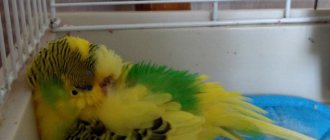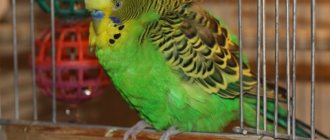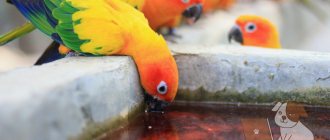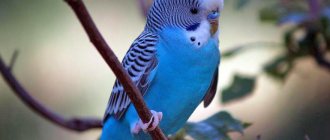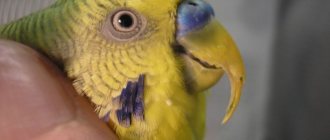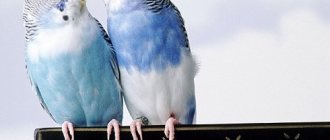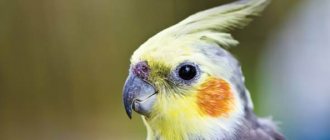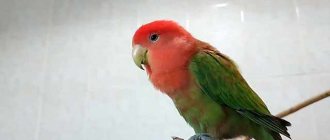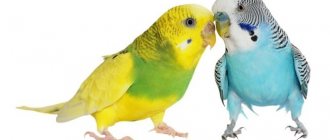Digestive disorders periodically occur in any pet, budgies are no exception. If this is your first time encountering the phenomenon of diarrhea in a parrot, think about where this trouble could have come from. The cause of diarrhea is sometimes the consumption of low-quality food, but it can also mean serious health problems.
Causes of loose stools in a budgie
Don't be alarmed if you sometimes notice a lot of moisture in bird droppings. This happens when a parrot drinks boiled water and feasts on juicy fruits, which weaken the intestines. The bird itself feels good, moves a lot, chirps. You should suspect something is wrong if the nature and frequency of bowel movements changes sharply: impurities of foam, blood, and mucus appear in the stool. Liquid droppings become green, white or yellow in color, and the smell becomes unbearable.
Main causes of diarrhea:
- Spoiled food. A new batch of grain feed turned out to be of poor quality, with mold or mildew. The parrot ate sour fruit or drank stagnant water.
- Poisoning. The feathered pet inhaled toxic aerosol fumes, tasted the leaf of a houseplant, and stole a prohibited product from a common table.
- Infectious diseases. The parrot caught the virus at the veterinary clinic or a bacterial infection developed due to a weakened immune system.
- Goiter inflammation. Disturbances in the digestive system lead to vomiting and diarrhea. This dangerous condition of the body requires immediate medical intervention, otherwise the bird will die.
- Infection with helminths. Where hygiene and disinfection rules are not followed, there is a very high risk of contracting worms and other parasites.
- Stress. The fragile psyche of a budgerigar cannot withstand nervous tension. Worrying about any reason puts the bird out of balance, and the body reacts to stress with the appearance of diarrhea.
A parrot treated with antibiotics may suffer from side effects such as diarrhea. Lack of vitamins and enzymes, pathologies of the gastrointestinal tract, chronic inflammation of the liver, problems with the organs of the endocrine system - all these diseases cause stomach upset in pets.
What is vaginal candidiasis? Causes of the disease
Vaginal candidiasis is an inflammatory disease of the genitourinary tract caused by yeast-like fungi of the genus Candida.
In most cases, the cause of vaginal candidiasis is Candida Albicans. It can reproduce successfully in an oxygen-free environment and grows especially well on tissues that contain large amounts of glycogen, including the mucous membrane of the female genitalia. Recently, doctors are increasingly discovering other pathogens of the Candida genus, but the overall frequency of their occurrence does not exceed 15-30%.
Internal risk factors for the development of vaginal candidiasis include endocrine diseases (diabetes mellitus, obesity, thyroid pathology, etc.), underlying gynecological diseases, disorders of local immunity; to external risk factors - taking antibacterial, glucocorticosteroid, cytostatic drugs, immunosuppressants, radiation therapy; wearing tight clothing, underwear made of synthetic fabrics, regular use of sanitary pads, prolonged use of intrauterine devices, vaginal diaphragms, douching, use of spermicides.
Symptoms of the disease
Diarrhea is not a disease as such. Diarrhea is a signal from the body that something has gone wrong. Frequent loose stools cause dehydration, loss of strength, and apathy. It is important not to miss these signs of serious illness:
- the budgie stops playing, most often sits on a perch, closing its eyes and ruffling its feathers;
- breathes heavily with open beak;
- is silent or makes unusual sounds;
- regurgitates food;
- refuses food;
- loses weight;
- drinks a lot or does not go near water at all;
- the color of the cere changes, the beak becomes covered with cracks.
A sick bird stops grooming itself, smoothing its feathers and cleaning its beak. You will understand very quickly that a bird has diarrhea: it goes to the toilet loosely, everything in the cage is splattered with droppings, the feathers under its tail are dirty, the cloaca is inflamed. Based on the appearance of the stool, you can guess what is causing the diarrhea:
- black droppings indicate intestinal bleeding;
- white or bluish excrement – inflammation of the pancreas;
- brown and yellow feces are observed with viral and bacterial infections;
- green diarrhea is a consequence of antibiotic therapy, dysbacteriosis;
- yellow droppings – liver problems.
What litter is considered normal?
Normal droppings should be brown-green to dark brown in color and spiral shaped. In addition to the feces themselves, parrot feces also contain urine in the form of a transparent liquid fraction and solid urates of a white or yellowish tint. Small birds have a fast metabolism, so they eat a lot and defecate often - normally up to 40-50 times a day. The color and consistency of feces can vary depending on the bird's diet: if it is predominantly grain-based, the feces will be firmer and brown in color, and if the parrot eats a lot of fresh fruits and vegetables, the feces will be thinner and green in color.
How to help a budgie with diarrhea
If watery discharge has been bothering your bird for a long time, you should consult a veterinarian. At home, you can also alleviate the parrot’s condition, help it recover and return to an active life.
We wash and disinfect
During the period of diarrhea, a budgie's cage gets very dirty, so you need to wash it and all equipment daily. While cleaning, place the bird in a box or carrier, but not with other pets. The patient is quarantined - he may be contagious. Wash the cage itself, all toys, drinkers, feeders, and perches with soap. Treat everything you can with steam, but do not use household chemicals. Place fresh bedding on the cage tray and return dried bird items inside.
The parrot itself also needs hygiene procedures. Wash the contaminated cloaca and tail feathers with cotton wool soaked in warm water or chamomile infusion. It soothes inflamed skin well. Dry the damp feathers lightly with a towel and place the little patient in a clean cage. You cannot wash the parrot completely - an unwell bird is already freezing.
Surrounding the bird with warmth
A draft is contraindicated even for healthy parrots, and for a sick bird it is simply destructive. Make sure that the room where the cage is located is warm and quiet. Maintain the air temperature at least +25 degrees. If necessary, turn on the heater, but at the same time make sure that the air does not dry out and humidify it.
Severe diarrhea in a parrot can cause chills, so it's a good idea to warm your bird under an infrared heat source. Alternatively, you can place an incandescent lamp near the cage, but then throw a scarf over it, creating a darkened area for resting and sleeping. By the way, for a quick recovery, the bird needs full sleep, which is possible only in the absence of sharp sounds. Try to protect your parrot from nervous shock by temporarily limiting the pet's access to the room.
Adjusting the diet
Until the cause of diarrhea is determined, change the food intake: leave only grain feed in the bird's diet. Millet should definitely be in the diet. Get rid of the food mixtures that your parrot was eating and buy a new box. Eliminate all fresh vegetables, fruits, herbs, and berries. Do not give favorite treats, seeds or nuts. Rice porridge with water has a strengthening effect and coats the irritated esophagus and intestines. Boil it without salt and add a little to the feeder once a day.
Change the drinking water in the drinking bowl several times a day, as it quickly becomes contaminated with droppings. You can use diluted chamomile infusion or rice water instead of water. Chamomile is a good antiseptic, and water after cooking rice helps prevent diarrhea no worse than medicine. Place a separate drinking bowl into which you will pour a decoction of blueberries or St. John's wort. You need to change it for a new one at least once every three hours.
We treat with medications
Without a doctor's prescription, you can use medications that are always in your home medicine cabinet. For example, activated carbon, smecta and enterosgel adsorb harmful substances and remove them from the stomach and intestines. One tablet of coal needs to be crushed and mixed with grain, after sprinkling it with water. To protect the liver from toxins, crush half a tablet of Karsil medication and add it to the food.
Live bacteria help restore the intestinal microflora: linex, lactobifadol. The veterinary drug Vetom 1.1 for birds improves vital signs and serves for the prevention and treatment of gastrointestinal diseases. If there is diarrhea, the parrot should receive this remedy in the doses recommended by the instructions.
The immunomodulator Gamavit provides a general strengthening effect. It must be diluted with water at the rate of 0.5 ml per 50 ml of liquid. The treatment course is at least a week. In addition, vitamin complexes and mineral supplements will help support a depleted body.
Acute diarrhea
A very common condition, usually resulting from eating food or water contaminated with bacteria, their toxins, viruses and protozoa. Infectious diarrhea is usually short-lived, so an infectious cause is rarely identified in patients with diarrhea for more than 10 days. Alcohol intoxication, various drugs, including antibiotics, cytotoxic drugs, non-steroidal anti-inflammatory drugs, can cause acute diarrhea.
Traveler's diarrhea is also recognized
. It develops in the first days in people traveling to exotic regions of the planet other than their own and is associated with the consumption of food and water with a different qualitative and quantitative composition of non-pathogenic microbial flora.
We can talk about the acute nature of diarrhea if the duration is no more than 3 weeks; otherwise, diarrhea is considered chronic.
Consequences and complications of diarrhea
Frequent bowel movements weaken the muscles that hold the cloaca in place. There are times when part of the cloaca falls out, dries out and causes great discomfort to the bird. The parrot scratches the irritated, itchy areas of the prolapsed organ with its claws and pecks at it, trying to relieve the pain. Such discomfort does not give the bird peace; it constantly suffers, wasting its last strength.
Prolonged diarrhea is a threat not only to the health, but also to the life of a budgie. If diarrhea does not stop for more than a day, the following complications are possible:
- the body becomes dehydrated;
- oppression of vital systems begins;
- internal organs cannot cope with intoxication;
- the blood thickens, its circulation becomes difficult;
- food is not digested, immediately passing from the esophagus into the intestines.
Without timely assistance, the parrot quickly loses weight and may die.
A budgerigar is a small bird, but it does not get sick any more easily than a large one. On the contrary, a fragile body is more susceptible to complications. Diseases in parrots often develop rapidly; the bird can die out in a matter of days. If you are unable to help your pet, do not hesitate - contact your veterinarian.
Diagnostics
Diagnosis of vaginal candidiasis begins with collecting complaints. The gynecologist clarifies what worries the patient, when and under what circumstances specific problems appeared, as well as what measures were taken to eliminate them and with what effect. Attention is paid to the medical history: previous diseases (inflammation of the urogenital tract, STDs are especially important), the number of pregnancies and births, the number of sexual partners, etc.
The next diagnostic stage is an examination in a gynecological chair, during which the doctor identifies characteristic changes: swelling, redness, discharge and plaque. When Lugol's solution is applied to tissues, white dots resembling semolina are visualized on them, which is a characteristic sign of the disease. To confirm the diagnosis, the doctor prescribes:
- microscopy of vaginal smears (during the process, spores and fungal cells are identified);
- culture of vaginal discharge;
- PCR and ELISA of the excreted to detect pathogen antigens;
- blood test: general (signs of an inflammatory process are detected), tests to detect antibodies to Candida - remove!
If necessary (for example, during a recurrent course of the disease), tests are carried out to identify risk factors: elevated blood glucose levels, immunodeficiency, etc.
External causes of the development of allergic dermatitis in children
The disease can be caused by one of the factors or a combination of several.
- Physical - friction or pressure on the skin of fabrics, leather products, high or low temperatures, humidity, electric current, ultraviolet or x-rays.
- Chemical - various acids and alkalis, substances included in creams and hygiene products, medicines, tobacco smoke.
- Biological - sap and pollen of plants, bites and secretions of insects and animals.
Of the plant agents, the most dangerous are the juice of celandine, hogweed, nettle, pollen of meadow and weeds.
In industrial cities in winter, there are widespread cases of contact dermatitis under the eyes and on the hands of children. Three factors are combined here: cold, chemical impurities in the air and touching the skin with wet mittens.
In infants, allergic inflammation can be caused by a combination of high humidity in diapers, fabric friction and the action of inappropriate cream.
A special type of contact dermatitis is phototoxic, when sunscreens degrade in sunlight and cause allergic damage to the epidermis.
